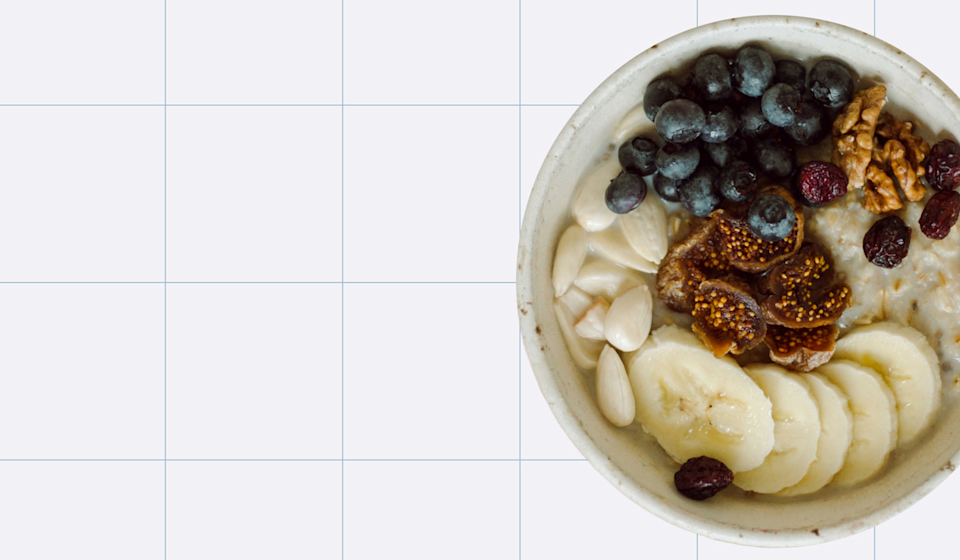Q: Can we chat about dietary fiber for a sec?
Data shows that more than 90% of Americans are not getting enough fiber in their diets. And considering all the ways fiber helps support the body (and digestive health in particular), there’s a solid case to be made for changing that—starting with the foods we eat, but potentially by incorporating a fiber supplement, too.
A quick crash course: Dietary fiber—also known as roughage or bulk—comes from parts of plant foods that the human body is unable to digest, which means it passes through the digestive system relatively intact. Dietary fiber is often divided into two types: soluble fiber and insoluble fiber. According to Dr. Mastaneh Sharafi, PhD, Ritual’s VP of Scientific Affairs and a registered dietitian, “Both types are beneficial, and both can help contribute to feelings of fullness” (which, in turn, may help support satiety).* (6, 19)
Q: Getting enough sleep?
There’s no two ways about it: Sleep is important—and a consistent lack of sleep can have a negative impact (brain fog, anyone?). The good news: Better sleep hygiene doesn’t have to be complicated—simple hacks like keeping the bedroom dark and limiting screen time, especially leading up to bedtime, can go a long way.* (7)
Q: Does your plate include a lot of refined carbohydrates?
White bread. Pasta. Bagels. While delicious, refined carbs don’t do a whole lot of favors. Studies show that diets rich in refined carbohydrates are often associated with not-so-ideal impacts; since the body digests refined carbs quickly, it could be a factor in why someone might feel hungry frequently. We recommend cutting down on processed foods (like refined grains), and opting for a balanced diet rich in whole grains, protein, fruits, vegetables, nuts, and legumes.* (12, 13)
Q: How about your H20 habits?
Consider this a daily reminder to drink more water. Proper hydration is crucial for the body—so much so that sometimes, feelings of thirst can be mistaken for feelings of hunger. If someone is having trouble staying satisfied (or is noticing an increased appetite that’s probably not attributed to lack of eating), try drinking a glass of water and see if that helps.* (14, 15, 18)
Q: Got healthy fats?
Dietary fat has satiating properties. There are many nutrient-dense foods that can be consumed to help support healthy fat intake—for example, sardines, salmon, tuna, and other cold water fatty fish all contain omega-3 fatty acids, along with other healthy fats; extra virgin olive oil is another excellent source of healthy fats—and it’s vegan, to boot.* (16, 17)
The essential takeaway
Hunger is not something to ignore. It’s a sign the body needs more food (or care, like managing stress and getting quality shut-eye). In the end, we suggest embracing a healthy, mindful approach to wellness: eating when hungry, drinking when thirsty, maintaining good sleep hygiene, and limiting processed foods whenever possible. Of course, if you have any questions about hunger, satiety, or nutrition in general, we recommend reaching out to a healthcare provider.*
References
- U.S. Department of Health and Human Services and U.S. Department of Agriculture. 2020 – 2025 Dietary Guidelines for Americans. 9th Edition. 2020.
- National Academies of Medicine. Dietary Reference Intakes for Energy, Carbohydrate, Fiber, Fat, Fatty Acids, Cholesterol, Protein, and Amino Acids (Macronutrients). 2005.
- Phillips SM. Current Concepts and Unresolved Questions in Dietary Protein Requirements and Supplements in Adults. Front Nutr. 2017 May 8;4:13.
- Office of Dietary Supplements. Dietary Supplements for Exercise and Athletic Performance. Fact sheet for health professionals. 2019.
- Thomas DT, Erdman KA, Burke LM. Position of the Academy of Nutrition and Dietetics, Dietitians of Canada, and the American College of Sports Medicine: Nutrition and Athletic Performance. J Acad Nutr Diet. 2016;116(3):501-528.
- U.S. Department of Health and Human Services, Food and Drug Administration (FDA). Interactive Nutrition Facts Label. Dietary Fiber Fact Sheet. March 2020.
- Luyster, F. S., Strollo, P. J., Jr, Zee, P. C., Walsh, J. K., & Boards of Directors of the American Academy of Sleep Medicine and the Sleep Research Society (2012). Sleep: a health imperative. Sleep, 35(6), 727–734.
- Taheri, S., Lin, L., Austin, D., Young, T., & Mignot, E. (2004). Short sleep duration. PLoS medicine, 1(3), e62.
- Pradhan, G., Samson, S. L., & Sun, Y. (2013). Ghrelin: much more than a hunger. Current opinion in clinical nutrition and metabolic care, 16(6), 619–624.
- McQuillan, M. E., Bates, J. E., Staples, A. D., & Deater-Deckard, K. (2019). Maternal stress, sleep, and parenting. Journal of family psychology : JFP : journal of the Division of Family Psychology of the American Psychological Association (Division 43), 33(3), 349–359.
- Morgan, E., Schumm, L. P., McClintock, M., Waite, L., & Lauderdale, D. S. (2017). Sleep Characteristics in Older Adults. Sleep, 40(5), zsx043.
- Aller, E. E., Abete, I., Astrup, A., Martinez, J. A., & van Baak, M. A. (2011). Starches, sugars. Nutrients, 3(3), 341–369.
- Yu, D., Shu, X. O., Li, H., Xiang, Y. B., Yang, G., Gao, Y. T., Zheng, W., & Zhang, X. (2013). Dietary carbohydrates, refined grains. American journal of epidemiology, 178(10), 1542–1549.
- Mattes R. D. (2010). Hunger and thirst: measurement and prediction of eating and drinking. Physiology & behavior, 100(1), 22–32.
- Popkin, B. M., D'Anci, K. E., & Rosenberg, I. H. (2010). Water, hydration, and health. Nutrition reviews, 68(8), 439–458.
- Samra RA. Fats and Satiety. In: Montmayeur JP, le Coutre J, editors. Fat Detection: Taste, Texture. Boca Raton (FL): CRC Press/Taylor & Francis; 2010. Chapter 15.
- Romani, A., Ieri, F., Urciuoli, S., Noce, A., Marrone, G., Nediani, C., & Bernini, R. (2019). Phenolic Compounds Found in Extra-Virgin Olive Oil, By-Products, and Leaf of Olea europaea L. Nutrients, 11(8), 1776.
- Ashok Kumar Vij V, Joshi A. Effect of excessive water intake. J Nat Sci Biol Med. 2014;5(2): 340-344.
- USDA, Agricultural Research Service, 2021. Usual Nutrient Intake from Food and Beverages, by Gender and Age, What We Eat in America, NHANES 2015-2018. 2021.
- Paddon-Jones D, Westman E, Mattes R, Wolfe R, Astrup A, Westerterp-Plantenga M. Protein, and satiety. The American Journal of Clinical Nutrition. 2008;87(5):1558-1561.












